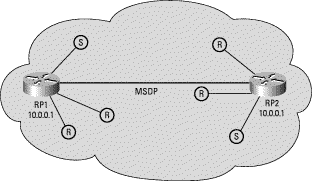


Multi-Level Rendezvous Point's
The idea behind multi-level RP's that that we connect shared trees in a hierarchy. The hierachy is such that Level-0 RPs are inside domains which are propogated from downstream routers to a Level-1 RP that may be in another domain. The Level-0 shared tree are conencted via Level-1 RPs. Should multiple Level-1 RP's are found, we iterate up to Level-2 RP's.
The problem to this approach is that we need to change the PIM protocol. Also, If we don't locate the Level-0 RP at the border, intermediate PIM routers think there there may be two RP's for the group.
Anycast Clusters
A potential solution to multi-level RP's is the use of Anycast clusters. The idea is that we connect the trees not in a hierachy (which would require data to flow all the way to the highest level RP), but to connect the trees together in a cluster. This shares burden among ISP as it places each RP in each domain as a boarder router. We then build RP clusters at interconnect points (or in dense-mode clouds) with group allocation per cluster, not per user or per domain.

The use of the closet border router in a cluser as the RP means that routers within a domain will use this RP, provided that you have an RP for that group range at an interconnect point. If not, you use the cloest RP at the interconnect point - which could be one in another domain.
Multicast Source Discovery Protocol (MSDP)
The idea behind MSDP is that we connect domains together. If we can't connect shared trees together easily, then we don't. This is achieved by connecting sources known to all trees rather than just connecting trees.
MSDP uses TCP on a RP to communicated in a peering session to another RP in another domain. Source Active (SA) messages indicate the active sending sources in a domain. A logical topology is build for the sole purpose of distributing SA messages.
MSDP works through the following processes,
·
A source goes active in a PIM-SM domain
·
Its packets get PIM registered to the domain's RP
·
The RP sends SA messages to its MSDP peers
·
A source goes active in a PIM-SM domain
·
These peers forward the SA to their peers away from the orginating RP
· If a peer in another domain has receivers for the group to which the source is sending, it joins the source (Flood and join method).
The advantages to MSDP is that there are no shared trees across domains, so each domain can depend solely on its own RP. We also do not need to store SA state at each MSDP peer. To improve the communication of SA's we could encapsulate data in SA messages for low-rate bursty sources, we could also cache SA state to speed up join latency.
Directory Services
The idea behind directory services that a sinlge shared tree across domains is used. Alternatively, we can use the source tree only.
In the case of a single shared tree across domains, an RP is lcoated in each domain....
blah
| Sun, 21 October, 2001 18:47 |
Room D14, High Energy Particle Physics, Dept. of Physics & Astronomy, UCL, Gower St, London, WC1E 6BT